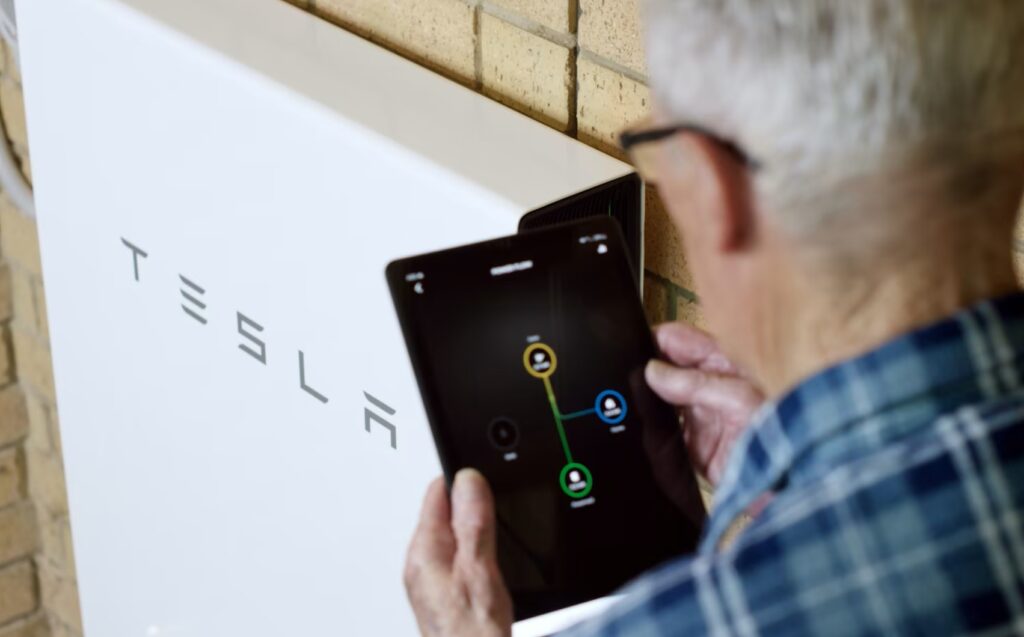Tesla has launched the fourth phase of South Australia’s Virtual Power Plant (VPP), adding as many as 3,000 additional low-income households.
Phase 4 introduces battery-only Tesla Powerwall installations, enabling thousands of homes that couldn’t previously participate in a VPP due to unsuitable rooftops for solar PV to join the transition to sustainable energy and reduce their cost of living.
The previous 3 phases played out over the past 6 years, starting back in 2017.
- Phase 1 (100 systems): Tesla launched a pilot program for its VPP in South Australia in 2017. The pilot program consisted of 100 solar and Tesla Powerwall home battery systems installed across South Australia Housing Authority (SAHA) properties. The pilot program was a success, and it demonstrated the technical capability of the systems to operate as a VPP.
- Phase 2 (1,000 systems): Tesla expanded its VPP to 1,000 systems in South Australia in 2018. The expansion of the VPP was funded by the Australian Renewable Energy Agency (ARENA) and the South Australian Government. The expanded VPP was able to provide energy and contingency frequency control ancillary services (FCAS) to the grid.
- Phase 3A (3,000 systems): an additional 3,000 solar and Tesla Powerwall home battery systems on Housing SA homes, expanding upon the 1,100 systems previously installed. Phase 3A aims to demonstrate the technical capability of VPPs to provide voltage support, fast frequency response (FFR) (less than 1 second response time) and inertia.
- Phase 3B (1,000 systems): an additional 1,000 solar and Tesla Powerwall home battery systems on private homes in South Australia. Phase 3B aims to demonstrate the technical capability of VPPs to provide voltage support, fast frequency response (FFR) (less than 1 second response time) and inertia.
This means the total aggregate Tesla Powerwalls in the VPP will now total more than 8,000. Some of the earlier installations will undoubtedly be the first generation Powerwall 1 with a capacity of 6.4 kWh, the majority will be the Powerwall 2 with a capacity of 13.5 kWh.
While we don’t know the exact breakdown, if they were all Powerwall 2, the SA VPP would be a collective energy bank of 108,000kWh. This is before we consider VPPs from other states.
| Feature | Powerwall 1 | Powerwall 2 | Powerwall 3 |
|---|---|---|---|
| Capacity | 6.4 kWh | 13.5 kWh | ? |
| Output | 3.3 kW continuous, 7 kW peak | 5 kW continuous, 10 kW peak | 13.5 kWh |
| Dimensions | 1755 mm x 350 mm x 175 mm | 1755 mm x 350 mm x 175 mm | ? |
| Weight | 125 kg | 135 kg | ? |
| Price | $3,000 USD | $5,500 USD | ? |
In areas where there is a surplus of solar generation, battery-only installations will provide an effective solution for storing the excess energy so it can be used at other times.
Existing VPP customers are reporting the benefits of joining the program.
“We’re saving about $20 a month off our electricity bills which helps tremendously. We’re pensioners so every bit helps. When there used to be blackouts I’d wake up and try and get the generator started in the early hours of the morning. Now, the power just goes straight back on with the battery and you don’t even notice.”
Craig joined South Australia’s VPP one year ago, Elizabeth East, Adelaide.
Tesla says they are committed to helping South Australia transition to a clean energy future. The VPP is a key part of this effort, and Tesla is proud to be working with the South Australian government and community to make it a success.
If you’re wondering about the crazy yellow bollards in the top picture, they are a result of some overzealous safety regulation that forces an indoor installation of batteries to be protected by bollards. This not only looks terrible but adds unnecessary costs to many installations. I hope our legislators can have a real re-think about this, particularly with those mounted on the side wall of garages.

History of Tesla VPP in Australia.
Tesla’s Virtual Power Plant (VPP) in Australia is a network of homes with solar panels and battery systems that are connected to the grid. The VPP can be used to store energy during periods of low demand and then release it back into the grid during periods of high demand. This can help to reduce peak demand and improve grid stability.
Tesla’s VPP in Australia was launched in 2017 with a pilot program in South Australia. The pilot program was a success, and Tesla has since expanded the VPP to other states in Australia, including New South Wales, Victoria, and Queensland.
As of March 2023, Tesla’s VPP in Australia has over 10,000 homes participating. The VPP has helped to reduce peak demand by over 100 megawatts and has saved participating homes an average of $200 per year on their electricity bills.
Tesla’s VPP is a significant step forward in the development of distributed energy resources. The VPP has the potential to help reduce Australia’s reliance on fossil fuels and improve grid stability.
Here is a timeline of the history of Tesla’s VPP in Australia:
- 2017: Tesla launches a pilot program for its VPP in South Australia.
- 2018: Tesla expands its VPP to New South Wales.
- 2019: Tesla expands its VPP to Victoria.
- 2020: Tesla expands its VPP to Queensland.
- 2021: Tesla’s VPP reaches over 10,000 homes.
- 2022: Tesla’s VPP helps to reduce peak demand by over 100 megawatts.
- 2023: Tesla’s VPP saves participating homes an average of $200 per year on their electricity bills.
For more information, head to Tesla’s Energy Plan page.
